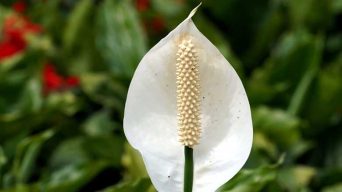If you’re like most people, you probably overwater your houseplants from time to time.
This is especially true for Peace lilies, which are notoriously easy to overwater.
An overwatered Peace lily will start to exhibit several different symptoms, and it’s essential to be able to identify them so that you can take the necessary steps to prevent further damage.
Here we will discuss how to identify an overwatered Peace lily and how to treat and prevent it from happening again!
What Are the Risks of Overwatering Peace Lily Plants?
A Peace Lily is a beautiful, easy-to-care-for plant that can brighten up any room in your home.
However, overwatering a Peace Lily plant can be risky, as it can lead to root rot and other health problems for the plant.
The most common risks of overwatering a Peace Lily are:
1. Root Rot
Root rot is a common problem for overwatered Peace lilies.
When the roots of a plant are continually moist, they begin to break down and decompose.
This process can lead to a loss of nutrients and a build-up of harmful bacteria and fungi.
In severe cases, root rot can kill a Peace lily.
2. Fungal Infections
Overwatered Peace lilies are susceptible to fungal infections.
The main reason for this is that overwatering leads to soggy soil, which provides the perfect environment for fungi to thrive.
Fungi love moist conditions, and they can quickly take over an overwatered plant.
In addition to causing the plant to rot, fungi can also attack the roots, leaves, and stems, causing severe damage.
3. Bacterial Diseases
Overwatered Peace lilies are at risk of developing bacterial diseases.
Bacteria thrive in wet, humid environments, and an overwatered Peace lily provides the perfect conditions for bacteria to grow.
When water droplets accumulate on the leaves, bacteria can be spread from one leaf to another.
In addition, they are more likely to develop rot caused by a bacterial infection.
Rot can cause the foliage of an overwatered Peace lily to turn yellow and fall off, damaging the roots.
4. Pest Infestations
Overwatered Peace Lilies are at risk of pest infestations.
Overwatering can drown the roots and lead to root rot. This weakens the plant and makes it more susceptible to pests.
Pests are attracted to overwatered plants because they provide a moist environment in which they can thrive.
In addition, overwatered plants are often nutrient-deficient, making them an easy target for pests.
5. Nutrient Deficiencies
Overwatered Peace Lilies are at risk of developing nutrient deficiencies.
When the roots of a plant are constantly moist, they can’t absorb as many nutrients from the soil.
As a result, overwatered plants often have low levels of essential nutrients, such as nitrogen, phosphorus, and potassium.
This can lead to several problems, such as stunted growth, yellow leaves, and leaf drop.
6. Stunted Growth
If a Peace Lily is overwatered, it can become stressed, resulting in yellow leaves, leaf drop, and stunted growth.
This is because overwatering can prevent the plant from getting enough oxygen, essential for healthy growth.
Overwatered Peace Lilies may also become leggy and lose their leaves as they struggle to survive in an environment that is not conducive to their health.
7. Death
In extreme cases, overwatering a Peace Lily plant can lead to its death.
When a plant is overwatered, it can’t receive sufficient oxygen to its roots.
When a plant’s roots remain wet for an extended period, it can cause them to rot and die, resulting in fungal and bacterial diseases that can rapidly spread and cause significant damage to the plant.
This damage manifests as stunted growth, wilting, and even death if the disease is not promptly treated.
How Does Overwatering a Peace Lily Occur
Numerous factors can cause the overwatering of a Peace Lily.
The reasons for overwatering Peace Lily plants can include a lack of drainage, too much water being added at once, not allowing the soil to dry out between waterings, or a pot that is too small for the plant, all of which can lead to root rot if not promptly treated.
The most common reason is when people water their plants too often or give them too much water at once.
Overwatering can also result from poor drainage in the potting soil, which causes the plant to sit in water for extended periods.
In addition, overwatering can be caused by using a pot that is too small for the plant or by planting it in a location that does not get enough sunlight.
Peace lilies need to be watered thoroughly, but only when the top inch of soil is dry.
In general, watering Peace Lily plants once a week is usually sufficient.
During the warmer seasons, it is important to check the top inch of soil regularly to ensure that it is not too dry, and if necessary, water Peace Lilies once a week to ensure that they receive the moisture they need to thrive.
However, the amount of water that needs to be given may vary depending on your home’s humidity levels, light, and temperature conditions.
How To Identify an Overwatered Peace Lily
It can be challenging to determine if a Peace Lily is overwatered, as the symptoms can vary depending on the cause of the problem.
However, a few telltale signs can help you identify an overwatered Peace Lily.
So, if you’re overwatering your Peace Lily, be on the lookout for these signs.
If you see any of these signs, it’s time to take action and figure out why the plant is overwatered.
By identifying the cause of the overwatering, you can then take steps to prevent it from happening again.
Signs of Overwatering
The most common signs of overwatering are:
1. Soil That Is Wet or Soggy
If you find that your Peace Lily’s soil is wet or soggy, it’s a sign that you’re overwatering your plant.
When you overwater a Peace Lily, the roots cannot take in the moisture they need, and the excess water accumulates in the soil.
This can lead to the development of root rot, which will damage the plant and make it more susceptible to pests.
Soil that is wet or soggy is also a sign of poor drainage in the potting soil. If the water can’t drain properly, it will sit in the pot and overwater the plant.
2. Wilted Leaves
When a plant is overwatered, the roots cannot receive the necessary oxygen to function correctly.
Consequently, the plant’s leaves will begin to wilt. This occurs because excessive water in the soil restricts the airflow to the roots.
In an attempt to save itself, the plant wilts its leaves, which is the fastest way to eliminate excess water.
If you notice your Peace Lily’s leaves are wilted, it’s a clear sign of overwatering. However, wilted leaves can also indicate other problems, such as pests or a lack of nutrients.
Furthermore, in high-temperature conditions, plants often wilt their leaves as a defense mechanism to eliminate excess water and reduce heat absorption from the environment.
Therefore, it’s crucial to observe additional signs of overwatering before concluding that excessive water is the sole issue.
3. Yellow Leaves
One of the most common problems with overwatered Peace Lilies is that the leaves will turn yellow.
This is caused by a lack of oxygen in the soil, which prevents the plant from being able to properly uptake nutrients.
As a result, Peace lily leaves will begin to turn yellow and then brown. This is a clear sign that it needs help.
Yellowing leaves can also be a sign of overwatering caused by poor drainage in the potting soil mix.
If you see that your Peace Lily’s leaves are yellow, it’s time to take action and figure out why the plant is overwatered.
4. Drooping Leaves
Another sign that a plant is overwatered is when the leaves start to droop.
When the plant is overwatered, the roots cannot take up enough water to support the leaves, causing them to droop.
Peace lily Drooping leaves can also be a sign that it is dehydrated, as it’s trying to conserve water.
If you see that your Peace Lily leaves are drooping, it’s important to figure out why it is overwatered.
5. Brown Leaf Tips
If you see that the tips of your Peace lily’s leaves are brown, it’s a sign that the plant is overwatered.
When a plant is overwatered, the roots cannot efficiently take up water and nutrients from the soil. This causes the leaves to turn brown and eventually die.
Also, overwatering can cause the leaves to develop fungal diseases, which will also turn the tips of the leaves brown.
5. Black Spots on the Leaves
The black spots on the leaves are a telltale sign that the plant is overwatered.
The plant’s leaves turn black, and the plant doesn’t seem to be able to uptake water correctly anymore.
When the roots of the plant are overwatered, they start to rot, preventing the plant from being able to uptake water correctly.
This can lead to the Peace Lily’s leaves turning black and falling off.
7. Leaves That Fall off Easily
If you touch the leaves of a Peace Lily plant and they fall off, it’s a sign that the plant is overwatered.
Leaves that fall off easily are usually a sign that the plant is in distress and not getting the nutrients it needs.
When a plant is overwatered, it can’t take up water or nutrients from the soil, eventually leading to the leaves falling off.
If you see that your Peace Lily’s leaves are falling off, it’s a clear sign that you’re overwatering your plant.
8. Mold or Mildew on the Leaves or Soil
If you see mold or mildew on the leaves or soil, it’s a sign that the plant is overwatered.
When a plant is overwatered, the roots are submerged in water and begin to rot.
The rot then spreads to the stem and leaves of the plant, causing the plant to turn yellow and die.
One of the first signs of overwatering is mold or mildew on the soil.
The mold or mildew results from the rotting roots, and it can quickly spread to other parts of the plant.
Mold is a black or greenish fungus that can grow on the soil, leaves, and stems of a plant.
Mildew is a white or gray fungus that grows on the surface of plants.
9. Mushy or Soft Roots
If the roots of your Peace Lily are mushy or soft, it’s a sign that the plant is overwatered.
When a plant is overwatered, the roots will become soft and mushy.
This is because the roots cannot get the oxygen they need from the water.
The waterlogged soil prevents air from reaching the roots, and as a result, the roots start to rot.
Root rot is a common problem with overwatered plants, and it can quickly kill the plant.
If you see that your Peace Lily’s roots are soft or mushy, it’s time to take action and figure out why the plant is overwatered.
How To Treat an Overwatered Peace Lily
If you believe your Peace lily is overwatered, there are a few things you can do to help it recover.
1. Cut Back on Watering
The first step is to cut back on watering.
Overwatered plants need far less water than those that are properly watered.
So, try to withhold water for a week or two and see if the plant perks up.
If you have been overwatering your plant for an extended period, you may need to wait a few weeks for it to recover.
During this time, do not water it at all.
Once you have cut back on watering and the plant has had a chance to recover, you can start watering it again.
Water it regularly, but do not overwater it. Only water it when the soil feels dry to the touch.
2. Repot the Plant
Repotting the plant may also help it to recover.
When you repot a plant, you are essentially giving it a new home.
You can either use the same container or get a new pot that is slightly bigger than the old one.
Make sure the pot has drainage holes in the bottom and that you place some gravel or stones at the bottom of the pot before adding the soil.
This will help keep the soil from washing away when you water the plant.
When you repot a plant, you should check the root system.
If there are some mushy or soft roots, you can cut them off with a sharp knife.
This will help prevent the rot from spreading to the healthy parts of the plant.
If there are any other signs of root rot, such as black or discolored roots, you should also cut those off.
Once you have repotted the plant, do not water it for a week.
After a week, you can start watering it again, but be sure to water it regularly and do not overwater it.
3. Replace the Soil
If the soil is wet and soggy, you may need to replace it.
When a plant is overwatered, the soil becomes waterlogged and does not allow air to reach the roots.
This can cause the roots to rot and the plant to die.
To prevent this from happening, you should repot in fresh soil every one to two years.
When you replace the soil, use a well-draining potting mix.
You can also add some perlite or sand to the potting mix to help it drain better.
4. Move the Plant to a Sunny Location
If your Peace lily is overwatered, it may not be getting enough sunlight.
Move the plant to a sunny location and see if that helps. Peace lily plants need at least six hours of sunlight a day.
They thrive with bright indirect light, so placing them near a window is ideal.
The sunlight will help the plant dry out and allow it to recover.
However, avoid direct sunlight, as it can be too intense for the plant and can cause it to become sunburned.
If you are going to place your plant in direct sunlight, make sure to monitor it closely and move it to a shadier spot if it begins to show signs of stress or wilting.
If you cannot move the plant to a sunny location, you can try using a grow light.
Grow lights provide artificial sunlight and are available at most garden stores.
If you are using a grow light, ensure it provides at least six hours of sunlight daily.
5. Don’t Fertilize the Plant
If your Peace lily is overwatered, you should not fertilize it.
Fertilizing an overwatered plant will only make the problem worse.
Wait until the plant has recovered and is properly watered before you start fertilizing it again.
Once the plant has recovered and is properly watered, you can begin to fertilize it again by adding a balanced fertilizer to the soil, which will provide essential nutrients to the plant and help it to grow and thrive.
6. Remove Any Damaged and Dead Leaves
If you see any dead leaves on the plant, remove them.
Dead leaves will only add to the problem and not help the plant recover.
By removing the damaged and dead leaves, you will help the plant focus its energy on recovering.
Trim any brown or yellow leaves to help your peace lily regain its healthy appearance.
Be careful not to trim too many leaves, as the plant will need them to photosynthesize and produce food.
7. Wait and Be Patient
The best thing you can do for an overwatered Peace lily is wait and be patient.
It will take time for the houseplant to recover.
Do not overwater it, and do not give up on it.
With a little bit of time and proper care, your overwatered Peace lily will recover.
How To Prevent Overwatering a Peace Lily?
Peace lily care is not complex, but overwatering them can be a common problem. However, overwatering a peace lily is easily preventable.
Here are some tips to help you prevent overwatering:
- Make sure the pot has drainage holes so excess water can escape.
- Don’t water the plant until the top of the soil feels dry to the touch.
- Water the plant thoroughly, then allow the soil to dry out before watering again.
- Don’t overwater the plant just because it’s been a while since you last watered it. Monitor the moisture levels in the soil and water accordingly.
- Use a watering can with a narrow spout to water the plant’s roots directly.
- Put the pot in a sunny spot where it will get at least four hours of direct sun per day.
If you follow these tips, you should be able to prevent overwatering and keep your peace lily healthy and happy.
Final Thoughts
Growing a Peace lily as an indoor plant can be a rewarding experience.
The Peace lily produces beautiful white flowers that can brighten up any room, and with proper care, the plant can bloom regularly, providing a continuous display of stunning blossoms that can bring a sense of peace and serenity to any home.
Still, it is essential to be aware of the potential issues that can occur, such as overwatering.
Houseplants can be an incredibly rewarding experience, as they bring life and beauty to any home, but it is important to be mindful of the potential problems that can arise from overwatering, as this can be detrimental to the health of your houseplants.
Overwatering is the number one cause of Peace lily death, so it is important to be able to identify the symptoms and take corrective action as soon as possible.
Knowing how to prevent overwatering and how to treat and correct it can help keep your Peace lily healthy and looking beautiful for many years.







